Local Save | ||
| ||
Terminology
- Version 6 Session
- The set of data loaded in memory from the database and visible to the user in applicative windows.
- Authoring windows
- Dark blue windows opened in the application (distinct from silver windows that are VPM Navigator windows)
- Locally Saved Session
- Save of session data in a local storage area (on the computer where the code is executed). Differs from a normal save, since saving also publishes modifications for all users to the PLM database.
- Advance save
- Capability to save session data at regular intervals.
- Auto Exit
- Defined period of inactivity after which the application exits.
- Planned Exit
- Preset date and time of exit.
![]()
Overview
The Local Save capability comprises the following functionalities:
- Local Save
- Restore.
- Local Save
-
The local save capability enables you to save locally, on your disk drive, authoring data loaded in a session but not committed in the PLM database:
- the local save capability is activated by default: specific options in the tab allow you to configure local saves, but if you need to deactivate local saves, it is not sufficient to uncheck the options in the tab; you can only deactivate the local save capability by setting an environment variable in your runtime environment
- the local save data is stored in a local storage area.
This command stores the data modified in authoring applications, the layout of the windows or any data necessary to recreate the authoring session as it was before the exit.
- Restore
-
If you perform a local save, exit your session, and then restart a session using the same logon (same user, role and server), the data restoration dialog will prompt you to restore the previously saved session, or start a new session.
If you choose to start a new session, the local save is deleted automatically to ensure persistent data consistency.
If you choose to restore the session, your original session is rebuilt by reopening the data in the same authoring windows as before the local save. All the data are restored in the same state as prior to the local save. This means that:
- authoring modifications that were not saved are restored in the session
- even if data has been modified by another user in the PLM Database, the data reopened is the data open before the local save
- VPM Navigator windows (Query result, Expand, Impact graph) are not reopened.
The restore capability is also obviously useful as a warm start mechanism in case of a system crash.
- Where Is the Local Save Mechanism Visible?
-
The local save mechanism is visible in the following areas:
- as already explained, in the Local Save tab
- when starting a Version 6 session
- the PLM Access>Local Save commands
- the PLM Access>Exit command; the following dialog box
prompts you to propagate your changes to the PLM database or perform
a local save:
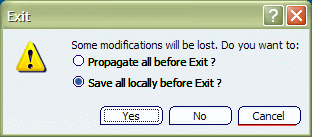
- when you exit the session automatically after a preset period on inactivity, using the Auto exit option
- at a planned date and time, using the Planned exit option.
![]()
Local Save
Select Tools>Options... then the General category, then select the Local Save tab.
The Local Save area contains the options for configuring looks like this:
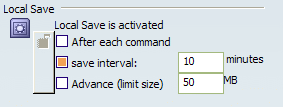
The message:
Local save is activated
confirms that the local save capability is activated by default. This means that the command PLM Access>Local Save is available by default allowing you to perform a local save of your session. It also means that, when exiting your session, you will be prompted to save your data locally or propagate the data to the PLM database.
Each time a local save has been successfully performed, the following message is displayed:
Local save successful
- After each command
-
This is the safest method of avoiding data loss, but the worst one for performance. When you exit any main command (because a command may contain sub-commands), the local save is performed automatically.
- Save Interval xxx minutes
-
This option allows you to set a timer. Once the specified time is reached, the software attempts to perform a local save immediately if possible. Whether an immediate local save is possible or not depends on the current command status and whether it can be interrupted or not, given that by default commands can not be interrupted, as indicated in the following table:
Command Status Local Save Response No active command A local save is started immediately Active command can be interrupted A local save is started immediately Active command cannot be interrupted The system waits for the current command to terminate before starting the local save - Advance
-
Performing a local save of large representations is not always transparent and impacts performance. The Advance option is a mechanism allowing automatic switching between the After each command mode and the save interval mode. When you activate this option, you set the limit size (50MB by default) at which the system switches between the two modes:
- if the size of modified data is less than the limit size, the local save is performed after each command
- If the size of modified data is greater than the limit size, the local save is performed every xxx minutes.
The size is based on the disk space occupied by stored data already MODIFIED.
The following examples will help you to understand the importance of the limit size (50MB is used as an example):
- if you IMPORT a model requiring 51MB of disk space, the switch will take place as soon as a modification is performed
- if you IMPORT a model requiring 49MB of disk space, then add a feature requiring 2MB in session, the switch will occur just after the modification
- if you modify a representation requiring 49MB of disk space in session, then add a feature requiring 2 MB, the local save is performed just after the command which added the feature, then the system waits xxx minutes before performing the next local save
- if you save a part requiring 49MB of disk space, then add a feature requiring 2MB, the switch will not occur because only 2MB is seen as modified.
However, be careful. Imagine now that you are working with two windows:
- W1 with 50MB of data
- W2 with 1MB of data
If you start to modify W2, the local save occurs after each command.
If you then modify W1, the size of the modified data exceeds 50MB, so the system switches to the save interval mode. During the next xxxx minutes, no local save will be started even if you only work on window W2.
The following message will inform that the mode has been switched from After each command mode to save interval mode:
Local save mode has been switched to time interval (from Advance mode option settings)
and from save interval mode to After each command mode:
Local save mode has been switched to after each command (from Advance mode option settings)
To sum up:
Local Save Mode Option After Each Command 
Save Interval 5 minutes 
Advance (after each interaction or for every 1 minute for data larger than 1MB) 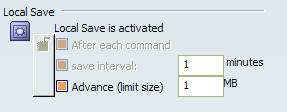
Note: Setting the Advance option automatically activates two options and greys out the other two options.
![]()
Persistent Data
The local save capability does not prevent full access to the original database. Logging into the database is mandatory before starting to restore data from the local save area.
During a local save, data saved are all the data opened in the session authoring windows including:
- opened data, modified or not: product structures, parts, applicative data, processes
- the layout of the authoring windows (position and size).
The following Data are not saved:
- VPM Navigator "silver" windows (Query Result, Expand, Impact Graph)
- settings: CATSetting files are the only reference
- the undo log
- volatile parameters like the viewpoint or the tree expansion.
All of the session will be saved to ensure model integrity and data consistency. Nothing will be added in the application to save only a subpart of the session.
Each local save is identified by:
- the name of the logged user
- the name of the application (CATIA)
- the date when the process was started.
The local save capability supports neither upward nor downward data compatibility and local save data will be destroyed by the migration process from one release to another.
Local save images can contain some necessary data for the database. They must not be destroyed directly without using a specific application. It is particularly true when using the editability context. A by-pass is to start a session and refuse to restore the old session image. This action will lead to the destruction of the associated files.
![]()
Data Restoration
- Restoring Data When Starting Version 6 Normally
-
If you performed a local save in a previous session, then restart Version 6, you will be prompted to choose to start a new session or restore the previous session:
- only if the local save capability is activated
- and only if the user attempting to log on already performed a locally saved session, if this session has not been deleted previously and if the directory used to store the session is available and the files are accessible.
Otherwise, a normal start from scratch is performed.
Assuming the previously defined conditions are met, you can choose either to restore the session (Restore) or to cancel the restore and launch the standard session login (New Session), or Exit (which allows you to restore the current local save image later):
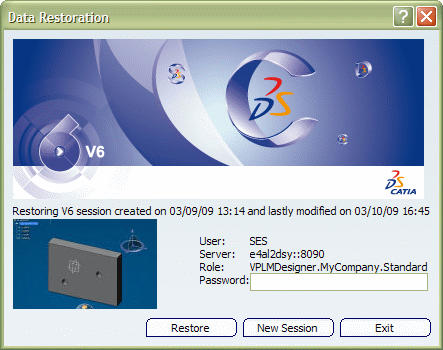
Moreover, on the left , there is a small preview of the image to restore, informing you when the image was created and the time of last modification. The dialog box also indicates user owner of the local save image, the server and the role used to create the image.
Whichever option you choose, you must of course enter your logon password.
- Restoring the Locally Saved Session
First, you have to authenticate by providing your logon password, and if the login is successful, authoring data stored in the Temporary Save are restored in session and authoring windows are reopened with these data. The session will be in the same state as it was when the last local save was performed, with regard to only authoring data.
Because only one local save session is available, this session will be overwritten the next time the perform a local save.
When logging in, if your username, role or server does not match the local save information, a message will be displayed explaining the problem and you will be allowed to try again:
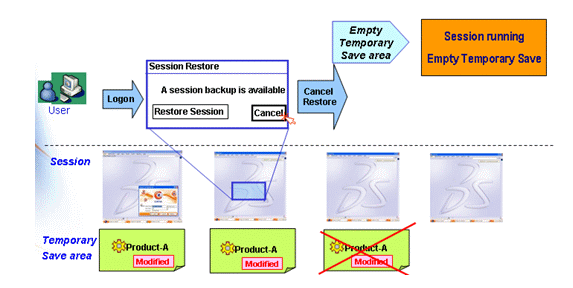
- Starting a New Session
If you start a new session, your own locally saved session is deleted and Version 6 starts as a regular empty session: the standard login panel appears.
To be more precise, the local save software identifies the Windows session owner and memorizes the application user and the role (not the password). Consequently, each Windows user has its own local save file.
- Exit
- By selecting this option, the user exits Version 6 without login.
- Restoring Your Session after a Crash: Warm Start
-
If a Version 6 crash occurs, the local save capability is useful for restoring the locally saved data. When you restart Version 6, you will also be prompted to choose between starting a new session or restoring the previous session:
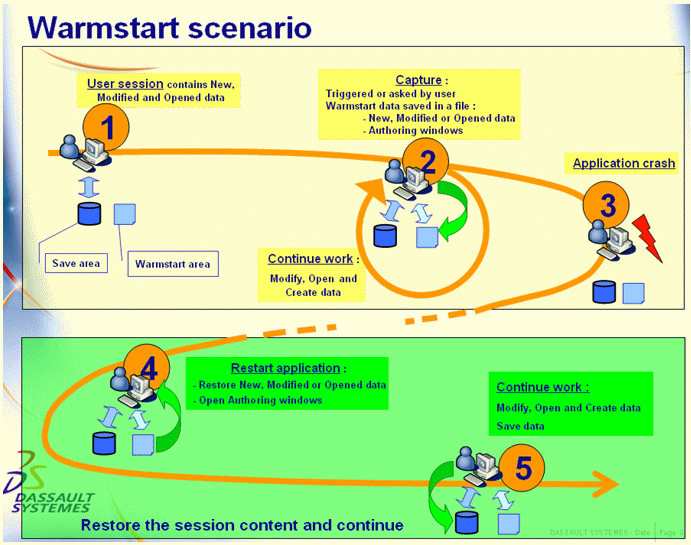
![]()
Auto exit

- Inactivity time before exit
-
This option lets you set the period of inactivity after which Version 6 exits automatically. You cannot enter a value lower than two minutes.
A warning message like this:

will be displayed during your Version 6 session warning you that the session will be terminated in xxx minutes.
A warning message like this:

will be displayed in front all the Windows applications to warn you about the auto exit.
The time during which the warning dialog is displayed is one minute. This is why you cannot enter a value lower than two minutes.
If you then perform interactions inside Version 6, the time out is cancelled and the count down is restarted from the beginning. To be more precise, the CATIA background is not sensitive, so you have to click inside an opened window or start a command to reset the sequence.
If Version 6 exits, the active command is cancelled and a local save (if activated) is performed before Version 6 exits.
Restriction: on Windows operating systems, if a message popup box is displayed, then automatic disconnection does not occur.
![]()
Planned exit

The Planned exit option enables you to set a predefined date and time at which the Version 6 session will automatically exit.
The period of time during which the warning dialog is displayed is 5 minutes.
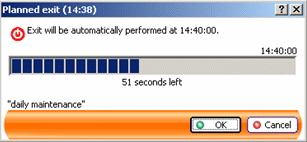
When closing the Planned exit dialog box, you can choose either to cancel the count down before exit (Cancel button) or just dismiss the dialog box to perform some other interactions before exit (OK button).
If Version 6 exits, the active command is cancelled and a local save (if activated) is performed before Version 6 exits.
![]()
Deactivating the Local Save Capability
As explained earlier, the local save capability is activated by default and cannot be deactivated during a session. Unchecking the local save options in the Local Save tab is not sufficient to deactivate the local save capability. To deactivate the local save capability, you must set the following environment variable in your runtime environment using the Environment Editor:
PLM_DeactivateLocalSave=TRUEWhen you start a Version 6 session, you will no longer be prompted to choose between restoring a session or starting a new session. When you then select the Local Save tab, the message:
Local Save is not activatedis displayed in the tab:
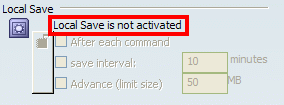
To reactivate the local save capability, delete the variable you set using the Environment Editor then restart a session.
![]()
Limitations
- Limitation 1
-
Any modification of P&O or security (access rights, security masks...) between the creation of the local save image and the next start of Version 6 when the local save capability is activated may lead to unpredictable results. In this case, the local save image is no longer valid. Please restart Version 6 without using local save.
- Limitation 2
-
The local save capability does not prevent full access to the original database. Logging into the database is mandatory before starting to restore data from the local save area.
- Limitation 3
-
There is no lock management in the local save area. Concurrent engineering questions are handled between the database and running sessions. Editability is not fully supported.
- Limitation 4
-
Local save images can contain some necessary data for the database. They must not be destroyed directly without using a specific application. It is particularly true when using the editability context.
A by-pass is to start a session and refuse to restore the old local save image. This action will lead to the destruction of the associated files.